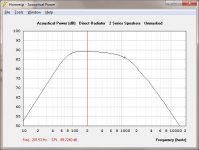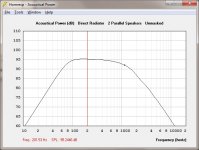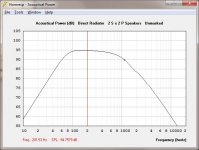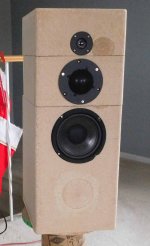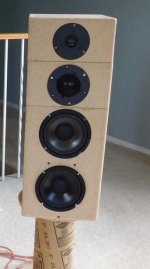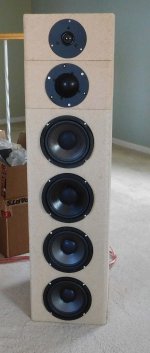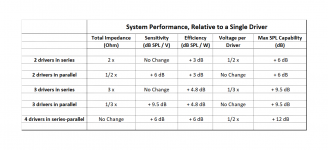2 same woofers, wired in series.
Assuming same voltage going in, it would be equal loudness ?
yes, it pulls half the current (because Z is doubled)……….
I'm thinking of 6db 2-way, and the woofs excursion would be halved since 2 of them.
And yes, I know of combing...……………..
Thoughts ?
Assuming same voltage going in, it would be equal loudness ?
yes, it pulls half the current (because Z is doubled)……….
I'm thinking of 6db 2-way, and the woofs excursion would be halved since 2 of them.
And yes, I know of combing...……………..
Thoughts ?
Each speaker will get the same current, how much voltage drop depends on the R. Usually close enuff but you should check.
Combing… How far apart are the woofers? How high do they have to go?
dave
Combing… How far apart are the woofers? How high do they have to go?
dave
Wire in series and get 2x resistance (1/2 current) so -3dB electrical drop, then +3dB acoustic gain for 2 drivers, nets out at 0dB gain.
Wire in parallel and get 1/2 resistance (2x current) so +3dB electrical gain, then +3dB acoustic gain for 2 drivers nets out at +6dB gain. Assuming your amp can drive it.
Wire in parallel and get 1/2 resistance (2x current) so +3dB electrical gain, then +3dB acoustic gain for 2 drivers nets out at +6dB gain. Assuming your amp can drive it.
Last edited:
Its not that simple of an answer in the practical world. Although you net zero gain in theory, the acoustical coupling (depending on how close the drivers are situated and at which frequencies) you will be awarded some mutual coupling. If the baffle is large enough, you will likely end up with 1.5 - 2dB gain at frequencies lower than the equivalent of 1/2 wavelength of driver spacing. The larger the baffle and the tighter the spacing, the greater the mutual coupling will be. This means you're dealing with sort of a driver array.
As already mentioned, this isn't the way coherent sources add up. +3dB is true for non coherent sources.then +3dB acoustic gain for 2 drivers
It's easy enough to verify.
These are a few HornResp sims for different driver configurations in a closed box in 2Pi space. The SPL is indicated by the red line and number at the bottom of the graph. There are also a few pics of models built and tested. This holds true for ABEC3 / AKABAK3 BEM simulations as well.
As you get closer to the floor, or wall, or corner you will reduce the radiation space from 2Pi to something less so you can get some more LF gain.
These are a few HornResp sims for different driver configurations in a closed box in 2Pi space. The SPL is indicated by the red line and number at the bottom of the graph. There are also a few pics of models built and tested. This holds true for ABEC3 / AKABAK3 BEM simulations as well.
As you get closer to the floor, or wall, or corner you will reduce the radiation space from 2Pi to something less so you can get some more LF gain.
Attachments
Last edited:
That's interesting. I'd like to see actual measurements of those systems.
There is a good writeup on this by Vance Dickason on this very topic and I believe its also in the loudspesker design cookbook. I build a lot of multiple LF driver systems and always see some form of coupling gain.
There is a good writeup on this by Vance Dickason on this very topic and I believe its also in the loudspesker design cookbook. I build a lot of multiple LF driver systems and always see some form of coupling gain.
Dickason, 7th Ed, pg 46-47 says the same thing.
Measurements for my active 3way evolution are at Modular active 3 way - work in progress There is an index on pg1 because the design is still evolving as I try to improve it. Different woofers configurations were sim'd and tried attempting to improve midbass and reduce floor bounce.
Measurements for my active 3way evolution are at Modular active 3 way - work in progress There is an index on pg1 because the design is still evolving as I try to improve it. Different woofers configurations were sim'd and tried attempting to improve midbass and reduce floor bounce.
Last edited:
dB(V) = C*20*log(V), I’m too lazy to look up the value for C. But each driver drops 6dB in SPL. Not 3.Wire in series and get 2x resistance (1/2 current) so -3dB electrical drop
Scott and i have been doing some work on possible 3 driver connections, isn’t parallel connection +9.77 dB? (can’t check, looks like i lost [the contents of] a file)
dave
Nope. They are coherent at long wavelengths, so +0dB. ‘Nuff said...remember, there are 2 drivers so (-6dB + -6dB) =-3dB
1 driver, Power = 1 W, 20Log(1) = 0.0 dB
2 drivers, Power = 2 W, 20Log(2) = 6.021 dB
3 drivers, Power = 3 W, 20Log(3) = 9.542 dB
2 drivers, Power = 2 W, 20Log(2) = 6.021 dB
3 drivers, Power = 3 W, 20Log(3) = 9.542 dB
Actually, this log function works for sound pressure level. Sound power level adds with the familiar 10*log(P) function. The sheet of Scott and Dave comes in handy btw.
But when does 'mutual coupling' and 'boundary reinforcement' apply?
If I put one speaker in the middle of the room and one on the ceiling, put the mic between them and set them to the same pressure I still expect to see +6dB.
If I put one speaker in the middle of the room and one on the ceiling, put the mic between them and set them to the same pressure I still expect to see +6dB.
What if you connect 16 8 ohm drivers in 4 parallel chains of 4 drivers series each 32 ohm making system back to 8 ohm. I cannot for the love of god understand that there will be any higher system sensitivity only 1/16 movement pr driver pr watt and of course 16x power handling and max SPL. Energy cannot magically appear.
Each driver will have 1/4 current and 1/4 voltage giving 1/16 power.
10 x log(1/16) = -12dB per driver.
16 drivers = 10 x log (2^4) = +12dB.
Sum 0dB sensitivity gain.
Only way to increase system sensitivity is to reduce system resistance.
10 x log(1/16) = -12dB per driver.
16 drivers = 10 x log (2^4) = +12dB.
Sum 0dB sensitivity gain.
Only way to increase system sensitivity is to reduce system resistance.
1 driver, Power = 1 W, 20Log(1) = 0.0 dB
2 drivers, Power = 2 W, 20Log(2) = 6.021 dB
3 drivers, Power = 3 W, 20Log(3) = 9.542 dB
what I meant by "power" is radiated acoustic power.
But when does 'mutual coupling' and 'boundary reinforcement' apply?
If I put one speaker in the middle of the room and one on the ceiling, put the mic between them and set them to the same pressure I still expect to see +6dB.
I would assume these rules apply when the drivers are close enough to be correlated signal and "in phase", so probably 1/4 wavelength or less... For widely spaced drivers, it probably gets complicated.
- Home
- Loudspeakers
- Multi-Way
- revisited, woofs in series............

